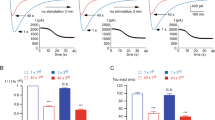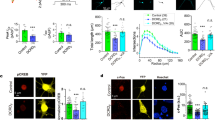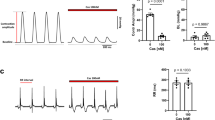Abstract
We investigated the regulation of T-type channels by Rho-associated kinase (ROCK). Activation of ROCK via the endogenous ligand lysophosphatidic acid (LPA) reversibly inhibited the peak current amplitudes of rat Cav3.1 and Cav3.3 channels without affecting the voltage dependence of activation or inactivation, whereas Cav3.2 currents showed depolarizing shifts in these parameters. LPA-induced inhibition of Cav3.1 was dependent on intracellular GTP, and was antagonized by treatment with ROCK and RhoA inhibitors, LPA receptor antagonists or GDPßS. Site-directed mutagenesis of the Cav3.1 α1 subunit revealed that the ROCK-mediated effects involve two distinct phosphorylation consensus sites in the domain II-III linker. ROCK activation by LPA reduced native T-type currents in Y79 retinoblastoma and in lateral habenular neurons, and upregulated native Cav3.2 current in dorsal root ganglion neurons. Our data suggest that ROCK is an important regulator of T-type calcium channels, with potentially far-reaching implications for multiple cell functions modulated by LPA.
This is a preview of subscription content, access via your institution
Access options
Subscribe to this journal
Receive 12 print issues and online access
$209.00 per year
only $17.42 per issue
Buy this article
- Purchase on Springer Link
- Instant access to full article PDF
Prices may be subject to local taxes which are calculated during checkout





Similar content being viewed by others
References
Bertolesi, G.E. et al. The Ca2+ channel antagonists mibefradil and pimozide inhibit cell growth via different cytotoxic mechanisms. Mol. Pharmacol. 62, 210–219 (2002).
Latour, I. et al. Expression of T-type calcium channel splice variants in human glioma. Glia 48, 112–119 (2004).
Panner, A. et al. Is there a role for T-type Ca2+ channel in glioma cell proliferation? Cell Calcium 37, 105–119 (2005).
Perez-Reyes, E. Molecular physiology of low-voltage-activated T-type calcium channels. Physiol. Rev. 83, 117–161 (2003).
Rodman, D.M. et al. Low-voltage–activated (T-type) calcium channels control proliferation of human pulmonary artery myocytes. Circ. Res. 96, 864–872 (2005).
Yunker, A.M. & McEnery, M.W. Immunological characterization of T-type voltage-dependent calcium channel CaV3.1 (α1G) and CaV3.3 (α1I) isoforms reveal differences in their localization, expression and neural development. J. Bioenerg. Biomembr. 35, 533–575 (2003).
Bourinet, E. et al. Silencing of the Cav3.2 T-type calcium channel gene in sensory neurons demonstrates its major role in nociception. EMBO J. 24, 315–324 (2005).
Mangoni, M.E. et al. Bradycardia and slowing of the atrioventricular conduction in mice lacking CaV3.1/α1G T-type calcium channels. Circ. Res. 98, 1422–1430 (2006).
Gu, Y. et al. Osteoblasts derived from load-bearing bones of the rat express both L- and T-like voltage-operated calcium channels and mRNA for α1C, α1D and α1G subunits. Pflugers Arch. 438, 553–560 (1999).
McRory, J.E. et al. Molecular and functional characterization of a family of rat brain T-type calcium channels. J. Biol. Chem. 276, 3999–4011 (2001).
Kim, D. et al. Lack of the burst firing of thalamocortical relay neurons and resistance to absence seizures in mice lacking α1G T-type Ca2+ channels. Neuron 31, 35–45 (2001).
Chen, C.C. et al. Abnormal coronary function in mice deficient in α1H T-type Ca2+ channels. Science 302, 1416–1418 (2003).
Moolenaar, W.H., Kranenburg, O., Postma, F.R. & Zondag, G.C. Lysophosphatidic acid: G protein signalling and cellular responses. Curr. Opin. Cell Biol. 9, 168–173 (1997).
Moolenaar, W.H. Development of our current understanding of bioactive lysophospholipids. Ann. NY Acad. Sci. 905, 1–10 (2000).
Contos, J.J. & Chun, J. The mouse lp(A3)/Edg7 lysophosphatidic acid receptor gene: genomic structure, chromosomal localization and expression pattern. Gene 267, 243–253 (2001).
An, S., Bleu, T., Hallmark, O.G. & Goetzl, E.J. Characterization of a novel subtype of human G protein-coupled receptor for lysophosphatidic acid. J. Biol. Chem. 273, 7906–7910 (1998).
Anliker, B. & Chun, J. Cell surface receptors in lysophospholipid signaling. J. Biol. Chem. 279, 20555–20558 (2004).
Gardell, S.E., Dubin, A.E. & Chun, J. Emerging medicinal roles for lysophospholipid signaling. Trends Mol. Med. 12, 65–75 (2006).
Lee, C-W., Rivera, R., Gardell, S., Dubin, A.E. & Chun, J. GPR92 as a new G12/13- and Gq-coupled lysophosphatidic acid receptor that increases cAMP, LPA5. J. Biol. Chem. 281, 23589–23597 (2006).
Yanagida, K., Ishii, S., Hamano, F., Nogichi, K. & Shimizu, T. LPA4/p2y9/GPR23 mediates rho-dependent morphological changes in a rat neuronal cell line. J. Biol. Chem. 282, 5814–5824 (2007).
Aznar, S. & Lacal, J.C. Rho signals to cell growth and apoptosis. Cancer Lett. 165, 1–10 (2001).
Mueller, B.K., Mack, H. & Teusch, N. Rho kinase, a promising drug target for neurological disorders. Nat. Rev. Drug Discov. 4, 387–398 (2005).
Riento, K. & Ridley, A.J. Rocks: multifunctional kinases in cell behaviour. Nat. Rev. Mol. Cell Biol. 4, 446–456 (2003).
Shimokawa, H. & Takeshita, A. Rho-kinase is an important therapeutic target in cardiovascular medicine. Arterioscler. Thromb. Vasc. Biol. 25, 1767–1775 (2005).
Dergham, P. et al. Rho signaling pathway targeted to promote spinal cord repair. J. Neurosci. 22, 6570–6577 (2002).
Kawano, Y. et al. Phosphorylation of myosin-binding subunit (MBS) of myosin phosphatase by Rho-kinase in vivo. J. Cell Biol. 147, 1023–1038 (1999).
Nakagawa, O. et al. ROCK-I and ROCK-II, two isoforms of Rho-associated coiled-coil forming protein serine/threonine kinase in mice. FEBS Lett. 392, 189–193 (1996).
Matsui, T. et al. Rho-associated kinase, a novel serine/threonine kinase, as a putative target for small GTP binding protein Rho. EMBO J. 15, 2208–2216 (1996).
Leung, T., Manser, E., Tan, L. & Lim, L. A novel serine/threonine kinase binding the Ras-related RhoA GTPase which translocates the kinase to peripheral membranes. J. Biol. Chem. 270, 29051–29054 (1995).
Storey, N.M., O'Bryan, J.P. & Armstrong, D.L. Rac and Rho mediate opposing hormonal regulation of the ether-a-go-go-related potassium channel. Curr. Biol. 12, 27–33 (2002).
Staruschenko, A. et al. Rho small GTPases activate the epithelial Na+ channel. J. Biol. Chem. 279, 49989–49994 (2004).
Amano, M. et al. The COOH terminus of Rho-kinase negatively regulates rho-kinase activity. J. Biol. Chem. 274, 32418–32424 (1999).
Shimizu, T. et al. Parallel coiled-coil association of the RhoA-binding domain in Rho-kinase. J. Biol. Chem. 278, 46046–46051 (2003).
Wolfe, J.T., Wang, H., Howard, J., Garrison, J.C. & Barrett, P.Q. T-type calcium channel regulation by specific G-protein βγ subunits. Nature 424, 209–213 (2003).
Welsby, P.J. et al. A mechanism for the direct regulation of T-type calcium channels by Ca2+/calmodulin-dependent kinase II. J. Neurosci. 23, 10116–10121 (2003).
Park, J.Y. et al. Activation of protein kinase C augments T-type Ca2+ channel activity without changing channel surface density. J. Physiol. (Lond.) 577, 513–523 (2006).
Hirooka, K. et al. T-Type calcium channel α1G and α1H subunits in human retinoblastoma cells and their loss after differentiation. J. Neurophysiol. 88, 196–205 (2002).
Wilcox, K.S., Gutnick, M.J. & Christoph, G.R. Electrophysiological properties of neurons in the lateral habenula nucleus: an in vitro study. J. Neurophysiol. 59, 212–225 (1988).
Huguenard, J.R., Gutnick, M.J. & Prince, D.A. Transient Ca2+ currents in neurons isolated from rat lateral habenula. J. Neurophysiol. 70, 158–166 (1993).
McKay, B.E. et al. Ca(v)3 T-type calcium channel isoforms differentially distribute to somatic and dendritic compartments in rat central neurons. Eur. J. Neurosci. 24, 2581–2594 (2006).
Todorovic, S.M., Jevtovic-Todorovic, V., Mennerick, S., Perez-Reyes, E. & Zorumski, C.F. Ca(v)3.2 channel is a molecular substrate for inhibition of T-type calcium currents in rat sensory neurons by nitrous oxide. Mol. Pharmacol. 60, 603–610 (2001).
Davies, S.P., Reddy, H., Caivano, M. & Cohen, P. Specificity and mechanism of action of some commonly used protein kinase inhibitors. Biochem. J. 351, 95–105 (2000).
Inoue, M. et al. Initiation of neuropathic pain requires lysophosphatidic acid receptor signaling. Nat. Med. 10, 712–718 (2004).
Nelson, M.T., Joksovic, P.M., Perez-Reyes, E. & Todorovic, S.M. The endogenous redox agent L-cysteine induces T-type Ca2+ channel–dependent sensitization of a novel subpopulation of rat peripheral nociceptors. J. Neurosci. 25, 8766–8775 (2005).
Ahmed, Z. et al. Disinhibition of neurotrophin-induced dorsal root ganglion cell neurite outgrowth on CNS myelin by siRNA-mediated knockdown of NgR, p75NTR and Rho-A. Mol. Cell. Neurosci. 28, 509–523 (2005).
Arimura, N. et al. Phosphorylation of collapsin response mediator protein-2 by Rho-kinase. Evidence for two separate signaling pathways for growth cone collapse. J. Biol. Chem. 275, 23973–23980 (2000).
Sah, V.P. et al. Cardiac-specific overexpression of RhoA results in sinus and atrioventricular nodal dysfunction and contractile failure. J. Clin. Invest. 103, 1627–1634 (1999).
Hirdes, W., Horowitz, L.F. & Hille, B. Muscarinic modulation of erg potassium current. J. Physiol. (Lond.) 559, 67–84 (2004).
Altier, C. et al. Opioid, cheating on its receptors, exacerbates pain. Nat. Neurosci. 9, 31–40 (2006).
Molineux, M.L. et al. Specific T-type calcium channel isoforms are associated with distinct burst phenotypes in deep cerebellar nuclear neurons. Proc. Natl. Acad. Sci. USA 103, 5555–5560 (2006).
Acknowledgements
We thank T. Snutch and J. McRory for providing wild-type Cav3 cDNAs, and M. Molineux for early recording tests in vitro. This work was supported by grants from the Canadian Institutes for Health Research. R.W.T. and G.W.Z. are Scientists of the Alberta Heritage Foundation for Medical Research (AHFMR). G.W.Z. is a Canada Research Chair. D.V. holds postdoctoral fellowships from the AHFMR and the Heart and Stroke Foundation of Canada.
Author information
Authors and Affiliations
Corresponding author
Ethics declarations
Competing interests
The authors declare no competing financial interests.
Supplementary information
Supplementary Fig. 1
Expression of endogenous LPA receptors in tsA-201 cells as assayed by RT-PCR analysis (PDF 40 kb)
Supplementary Fig. 2
Analysis of Rho kinase phosphorylation sites on the Cav3.1 channel. (PDF 35 kb)
Supplementary Fig. 3
Average peak current amplitudes obtained from Cav1.2, Cav2.1 and Cav2.2 calcium channels under control conditions, and after 15-min incubation with LPA with or without pretreatment by Fasudil. (PDF 50 kb)
Supplementary Table 1
Lack of direct effects of inhibitors on half-activation potentials and peak current amplitude of rat Cav3.1 T-type calcium channels. (PDF 52 kb)
Supplementary Table 2
The effects of LPA (10 μM) and Fasudil (10 μM) on paramters of tonic spike discharge in LHb neurons in vitro (PDF 56 kb)
Rights and permissions
About this article
Cite this article
Iftinca, M., Hamid, J., Chen, L. et al. Regulation of T-type calcium channels by Rho-associated kinase. Nat Neurosci 10, 854–860 (2007). https://doi.org/10.1038/nn1921
Received:
Accepted:
Published:
Issue Date:
DOI: https://doi.org/10.1038/nn1921
This article is cited by
-
Neuronal Cav3 channelopathies: recent progress and perspectives
Pflügers Archiv - European Journal of Physiology (2020)
-
A novel phospho-modulatory mechanism contributes to the calcium-dependent regulation of T-type Ca2+ channels
Scientific Reports (2019)
-
Role of T-type channels in vasomotor function: team player or chameleon?
Pflügers Archiv - European Journal of Physiology (2014)
-
T-type calcium channel blockers as neuroprotective agents
Pflügers Archiv - European Journal of Physiology (2014)



